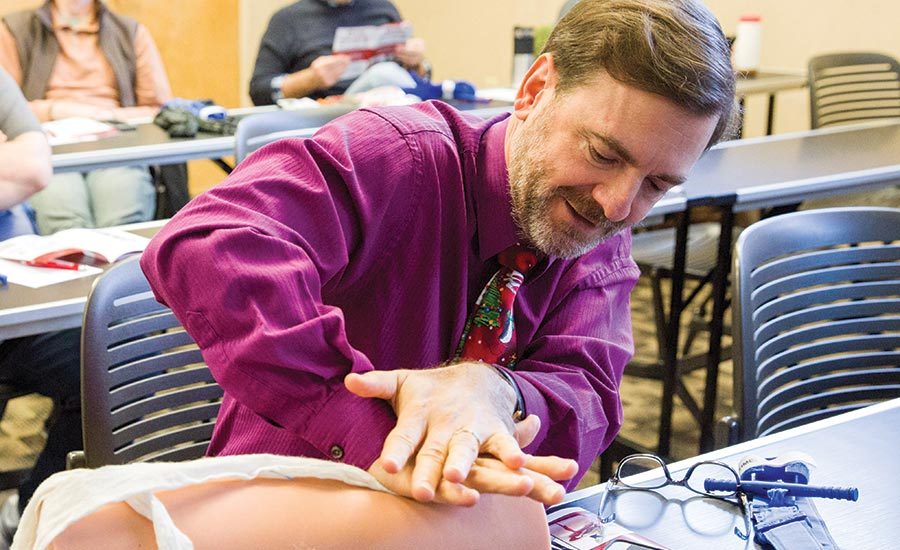How Three Universities Embraced Stop the Bleed Training
University security can take a leading role in disseminating Stop the Bleed training as part of their formal security and safety programs

A University of Georgia Professor learns how to apply direct pressure, pack a wound and apply a tourniquet to Stop the Bleed.
Photo courtesy of the University of Georgia Police Department

A Cobb Fire fighter takes the pulse of a Kennesaw State University nursing student after she applied a Combat Application Tourniquet to herself.
Photo courtesy of Kennesaw State University Department of Public Safety and University Police Department

About the Authors
Andy Altizer is the Director of Emergency Management at Kennesaw State University, Captain Adam Fouche is a 15-year veteran of the University of Georgia Police Department, Steve Harris is the Director of the Office of Emergency Preparedness and Insurance and Claims Management for the University of Georgia, and Sam Sharter, MSN, RN, is Senior Administrator for Emory University’s Office of Critical Event Preparedness and Response (CEPAR).



University security can take a leading role in disseminating Stop the Bleed training as part of their formal security and safety programs.
In fall 2015, a wounded student made a frantic call to University of Georgia Police from a wooded area on the edge of campus. He had severely cut both of his wrists in an attempt to take his own life. But as he lay in the dark woods bleeding, he decided to reach out for help. Officers combed the area and by following his screams for help, were able to find the student, still alive but bleeding from both wrists. Because of their training and familiarity with their equipment, officers carried to the scene with them their bleeding control kits and used two tourniquets to stop the victim’s bleeding.
The responding officers had a sense for what they might have been walking into because they had the foresight to carry with them some life-saving trauma gear, including tourniquets. After stopping the bleeding, the officers worked with fire and rescue personnel to extricate the wounded student from the woods and get him to the hospital.
It’s only one of countless stories over the last six years of University of Georgia Police officers using their medical training and equipment during life-threatening medical emergencies. Department officers have been credited multiple times for using tourniquets, hemostatic gauze, CPR, AEDs and naloxone to render aid in both life-threatening and non-life-threatening emergencies, from kitchen accidents to cardiac arrests to drug overdoses to attempts at serious self-harm.
These stories aren’t unique to the University of Georgia. Universities across the nation have implemented or are considering Stop the Bleed programs on campus for just such medical emergencies. Like so many other preparedness programs, there seems to be more mitigation opportunities than available funding. Campuses must continuously weigh costs with threats and risks. Providing lifesaving equipment and supplies for a specific, but perhaps unlikely emergency, takes prior planning, creative programming and funding and executive support. However, such programs, especially those related to bleeding control, have far-reaching applicability outside of uses in just criminal attacks. College campuses are not immune from everyday traumatic accidents, including motor vehicle crashes, lab accidents, construction accidents, attempts at self-harm and accidental cuttings. Bystanders can use bleeding control equipment and techniques to save lives in all of those situations.
According to The Hartford Consensus report, which was developed after the shooting at Sandy Hook Elementary School:
- Uncontrolled bleeding is the most significant preventable cause of death in the pre-hospital environment.
- All responders – civilian and professional – should have the education and necessary equipment for hemorrhage control.
- Civilian bystanders should act as “immediate responders.”
- The public needs access to bleeding control bags that include pressure bandages, safe and effective hemostatic dressings, effective tourniquets and personal protective gloves placed in locations that are widely accessible, similar to AEDs, and that are readily visible and available for use within three minutes of injury.
A copy of the report is at https://stopthebleedingcoalition.org/index.php/hartford-consensus/.
Providing resources and training to “stop the bleed” adds to the overall campus safety. Implementing such a program depends on the individual campus, which always includes funding available for such a program. Here are three additional examples of universities that have implemented such programs, including an overview of supplies, kit locations and training.
Emory University
Emory University issued combat application tourniquets (CATs) to all of its police officers in 2013. The Emory IFAKs contains two pairs of gloves, a sharpie, a roll of two-inch tape, a Vaseline gauze pad, a combat application tourniquet and two combat dressings. Additionally, Individual First Aid Kits (IFAKs) are on all police vehicles to augment the existing first aid supplies carried by officers. Emory’s police officers receive annual training in CPR, the use of an AED, first aid and bleeding control, to include the use of a tourniquet.
Six mass casualty bags were obtained that contain 20 IFAKs. A package of triage cards has also been attached to these bags. For large events such as commencement and concerts, security pre-stages the mass casualty bags. Two of these bags have been placed on the student EMS First Response Vehicles (Emory EMS). The CEPAR vehicle also carries a mass casualty bag, additional medical supplies, junctional tourniquets and hemostatic agents.
Emory is in the process of developing a class for students, staff and faculty that provides training in key lifesaving skills. These include compression only CPR; use of an AED; treating an obstructed airway in an adult; bleeding control techniques, including the use of a tourniquet; recognition of opioid overdose; and use of Narcan.
With respect to public access Stop the Bleed Supplies, Emory is working to secure funding to place IFAKs with each of the more than 300 AEDs that have been deployed across Emory campuses. Campus security says it believes the kits will augment the ability of immediate responders on campus to provide lifesaving care.
Kennesaw State University (KSU)
KSU provides a small Bleeding Control Kit in ground and first floor AED boxes in each building on its two campuses. These boxes are identified with a Stop the Bleed sticker. Each kit includes a CAT and Stretch Wrap and Tuck-Tourniquet (SWAT-T), gauze and a small packet of Celox. Every police officer and emergency management staff carry a CAT. Supervisor Patrol, Emergency Management and the Mobile Command Vehicle have Junctional Tourniquets, XStats and a Trauma First Aid kit. The university has a Critical Incident Response Trailer (CIRT) that includes a variety of mass casualty supplies including additional CATs, SWAT-Ts, XStats and trauma kits.
Bleeding Control Classes are offered nearly every month to the general campus population, with a focus on the volunteer Crisis Coordinators in each building. The local fire department (Cobb County) provides most of the training. Every member of KSU’s Office of Emergency Management has completed the 48-hour Emergency Medical Responder and three-day Tactical Emergency Casualty Care (TECC) classes. KSU is the process of having at least one police officer per shift complete TECC. KSU is now targeting various student groups to train in Stop the Bleed, including Resident Assistants and members of the Student Nurses Association. Some faculty members are now requiring students to complete a Stop the Bleed class before granted after-hour access to buildings.
KSU Student Health Services operated by Wellstar provided the Bleeding Control kits in the AED boxes. KSU also received a small grant from the Georgia Emergency Management Agency (GEMA) that provided additional funding for Stop the Bleed supplies. Funding for additional supplies were included in the OEM annual budget.
Future aspirations to complement the existing program at KSU include a more comprehensive trauma kit for larger capacity areas, including athletic venues and graduation sites.
University of Georgia
The University of Georgia (UGA) first implemented its bleeding control program for law enforcement in 2013 through a joint program between the UGA Office of Emergency Preparedness and the UGA Police Department. One vendor in bleeding control equipment provided training to UGA Police and UGA Office of Emergency Preparedness (OEP) trainers on Tactical Emergency Casualty Care (TECC). All officers received a personal tourniquet carried on their duty belts, and all UGA Police patrol vehicles were outfitted with bleeding control kits (tourniquet, hemostatic gauze, pressure bandages, chest seals). As the program on the law enforcement side grew, UGA developed additional instructors and hosted free TECC classes through the Federal Law Enforcement Training Center.
On the civilian side, UGA embraced the national Stop the Bleed initiative in early 2016. The UGA Office of Emergency Preparedness placed public access bleeding control kits in AED cabinets across the state on many of UGA’s campuses and research properties. OEP also organized the placement of bleeding control kits on research boats and other unique locations, as well as mass casualty bleeding control kits at the university’s large athletic venues. The kits were intentionally stocked with non-expiring items, including the CAT tourniquet, pressure dressing, gauze, gloves and trauma shears. Currently, UGA has nearly 400 of the kits distributed across its campus and other properties. The larger mass casualty kits at UGA sports venues, including Sanford Stadium and Stegeman Coliseum, are equipped with numerous tourniquets, pressure dressings, hemostatic gauze, survival blankets, portable stretchers and other medical supplies. OEP also teaches the bleeding control course across campus.
In addition to the bleeding control kits in UGA Police vehicles, the entire police vehicle fleet is equipped with AEDs. Four specialty emergency medical police vehicles (designated by a Red Cross emblem on the sides of the vehicle) contain an additional mass casualty kit (six extra bleeding control kits and portable stretchers), breaching tools, ballistic shields and additional ballistics capabilities. At least one vehicle is operated at all times, and the vehicles are also staged at large special events, public gatherings and athletic events to provide easy access to equipment for officers.
In recognition of the need to enhance the department’s medical programs, the police department created a medical officer position to oversee department medical training and medical supplies, including bleeding control kits, AEDs and Narcan. All UGA Police officers are training in TECC techniques.
Conclusion
It was not long ago that universities decided to place AED on campus. Now, bleeding control kits are becoming more prominent on university campuses. The Stop the Bleed program can be managed in countless ways based on the various demographics, threat/risk environment and available resources. Universities have a unique opportunity to provide training in the lifesaving skills referenced in this article. Providing this training will make campuses more resilient and communities better prepared to stop the bleed.
Looking for a reprint of this article?
From high-res PDFs to custom plaques, order your copy today!








